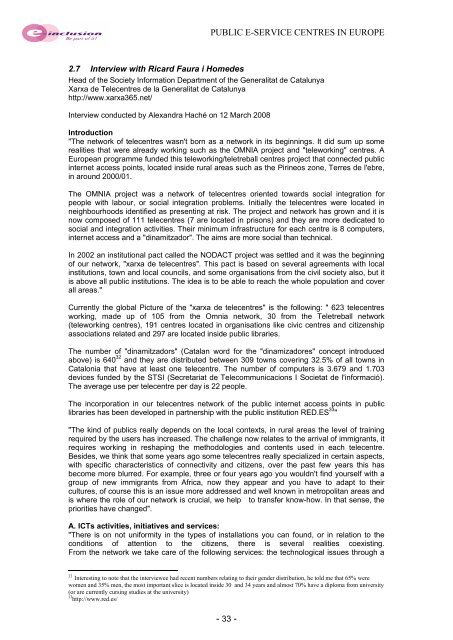Comparative Study of Public e-Service Centres in - ePractice.eu
Comparative Study of Public e-Service Centres in - ePractice.eu
Comparative Study of Public e-Service Centres in - ePractice.eu
You also want an ePaper? Increase the reach of your titles
YUMPU automatically turns print PDFs into web optimized ePapers that Google loves.
PUBLIC E-SERVICE CENTRES IN EUROPE<br />
2.7 Interview with Ricard Faura i Homedes<br />
Head <strong>of</strong> the Society Information Department <strong>of</strong> the Generalitat de Catalunya<br />
Xarxa de Telecentres de la Generalitat de Catalunya<br />
http://www.xarxa365.net/<br />
Interview conducted by Alexandra Haché on 12 March 2008<br />
Introduction<br />
"The network <strong>of</strong> telecentres wasn't born as a network <strong>in</strong> its beg<strong>in</strong>n<strong>in</strong>gs. It did sum up some<br />
realities that were already work<strong>in</strong>g such as the OMNIA project and "telework<strong>in</strong>g" centres. A<br />
European programme funded this telework<strong>in</strong>g/teletreball centres project that connected public<br />
<strong>in</strong>ternet access po<strong>in</strong>ts, located <strong>in</strong>side rural areas such as the Pir<strong>in</strong>eos zone, Terres de l'ebre,<br />
<strong>in</strong> around 2000/01.<br />
The OMNIA project was a network <strong>of</strong> telecentres oriented towards social <strong>in</strong>tegration for<br />
people with labour, or social <strong>in</strong>tegration problems. Initially the telecentres were located <strong>in</strong><br />
neighbourhoods identified as present<strong>in</strong>g at risk. The project and network has grown and it is<br />
now composed <strong>of</strong> 111 telecentres (7 are located <strong>in</strong> prisons) and they are more dedicated to<br />
social and <strong>in</strong>tegration activities. Their m<strong>in</strong>imum <strong>in</strong>frastructure for each centre is 8 computers,<br />
<strong>in</strong>ternet access and a "d<strong>in</strong>amitzador". The aims are more social than technical.<br />
In 2002 an <strong>in</strong>stitutional pact called the NODACT project was settled and it was the beg<strong>in</strong>n<strong>in</strong>g<br />
<strong>of</strong> our network, "xarxa de telecentres". This pact is based on several agreements with local<br />
<strong>in</strong>stitutions, town and local councils, and some organisations from the civil society also, but it<br />
is above all public <strong>in</strong>stitutions. The idea is to be able to reach the whole population and cover<br />
all areas."<br />
Currently the global Picture <strong>of</strong> the "xarxa de telecentres" is the follow<strong>in</strong>g: " 623 telecentres<br />
work<strong>in</strong>g, made up <strong>of</strong> 105 from the Omnia network, 30 from the Teletreball network<br />
(telework<strong>in</strong>g centres), 191 centres located <strong>in</strong> organisations like civic centres and citizenship<br />
associations related and 297 are located <strong>in</strong>side public libraries.<br />
The number <strong>of</strong> "d<strong>in</strong>amitzadors" (Catalan word for the "d<strong>in</strong>amizadores" concept <strong>in</strong>troduced<br />
above) is 640 32 and they are distributed between 309 towns cover<strong>in</strong>g 32.5% <strong>of</strong> all towns <strong>in</strong><br />
Catalonia that have at least one telecentre. The number <strong>of</strong> computers is 3.679 and 1.703<br />
devices funded by the STSI (Secretariat de Telecommunicacions I Societat de l'<strong>in</strong>formació).<br />
The average use per telecentre per day is 22 people.<br />
The <strong>in</strong>corporation <strong>in</strong> our telecentres network <strong>of</strong> the public <strong>in</strong>ternet access po<strong>in</strong>ts <strong>in</strong> public<br />
libraries has been developed <strong>in</strong> partnership with the public <strong>in</strong>stitution RED.ES 33 "<br />
"The k<strong>in</strong>d <strong>of</strong> publics really depends on the local contexts, <strong>in</strong> rural areas the level <strong>of</strong> tra<strong>in</strong><strong>in</strong>g<br />
required by the users has <strong>in</strong>creased. The challenge now relates to the arrival <strong>of</strong> immigrants, it<br />
requires work<strong>in</strong>g <strong>in</strong> reshap<strong>in</strong>g the methodologies and contents used <strong>in</strong> each telecentre.<br />
Besides, we th<strong>in</strong>k that some years ago some telecentres really specialized <strong>in</strong> certa<strong>in</strong> aspects,<br />
with specific characteristics <strong>of</strong> connectivity and citizens, over the past few years this has<br />
become more blurred. For example, three or four years ago you wouldn't f<strong>in</strong>d yourself with a<br />
group <strong>of</strong> new immigrants from Africa, now they appear and you have to adapt to their<br />
cultures, <strong>of</strong> course this is an issue more addressed and well known <strong>in</strong> metropolitan areas and<br />
is where the role <strong>of</strong> our network is crucial, we help to transfer know-how. In that sense, the<br />
priorities have changed".<br />
A. ICTs activities, <strong>in</strong>itiatives and services:<br />
"There is on not uniformity <strong>in</strong> the types <strong>of</strong> <strong>in</strong>stallations you can found, or <strong>in</strong> relation to the<br />
conditions <strong>of</strong> attention to the citizens, there is several realities coexist<strong>in</strong>g.<br />
From the network we take care <strong>of</strong> the follow<strong>in</strong>g services: the technological issues through a<br />
32 Interest<strong>in</strong>g to note that the <strong>in</strong>terviewee had recent numbers relat<strong>in</strong>g to their gender distribution, he told me that 65% were<br />
women and 35% men, the most important slice is located <strong>in</strong>side 30 and 34 years and almost 70% have a diploma from university<br />
(or are currently curs<strong>in</strong>g studies at the university)<br />
33 http://www.red.es/<br />
- 33 -
















